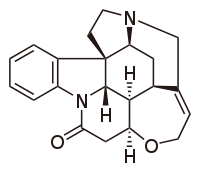Strychnine
| Strychnine | |
|---|---|

| |

| |
| Other names | Strychnidin-10-one |
| Identifiers | |
3D model (JSmol)
|
|
| ECHA InfoCard | 100.000.290 |
PubChem CID
|
|
CompTox Dashboard (EPA)
|
|
| |
| Properties | |
| C21H22N2O2 | |
| Molar mass | 334.41 |
| Melting point | 284-286 °C |
| Except where noted otherwise, data are given for materials in their standard state (at 25 °C, 100 kPa) Infobox disclaimer and references | |
Strychnine is a poisonous substance which is naturally produced by the plant Strychnos nux-vomica. Together with brucine, another poison, strychnine is found in the leaves and seeds of this plant. They are a rather extreme example of the way some plants protect themselves against herbivores. The substances were discovered early in the 19th century, but it took about 150 years before Robert Robinson worked out their structure.[1]
When purified, strychnine is a very toxic colorless crystalline alkaloid. It is very poisonous, the LD50 is about 10 mg. Strychnine is soluble in alcohol and chloroform, but not in water.
Strychnine has few uses today. It can act as a stimulant, much like caffeine, and is on the list of substances tested for doping in sports.[2] It was used as a pesticide, for killing small vertebrates such as birds and rodents.
Poisoning[change | change source]
Strychnine causes muscular convulsions. It leads to death through asphyxia or exhaustion. The most common source is from the seeds of the Strychnos nux vomica tree. Strychnine is one of the most bitter substances known. Its taste is detectable in concentrations as low as 1 ppm.
Between 30 and 120 mg can kill an adult human. Strychnine is rapidly absorbed by the mucous membranes. If it is given under the skin, or intravenously, a quantity of 15 mg may be enough to kill an adult. Benzodiazepines (such as Diazepam) are used by default for emergency treatment.
Unlike the illustrations given in fiction crime novels, Strychnine is not very good for killing someone (when given orally). This is because even diluted at 1:130.000 it can still be tasted. Despite this, some murders happened with Strychnine. Thomas Neill Cream, a serial killer, used it on some of his victims.
Because of its high toxicity and tendency to cause convulsions, the use of strychnine in medicine was eventually abandoned once safer alternatives became available.
Related pages[change | change source]
References[change | change source]
- ↑ Todd L. & Cornforth J.W. 1976. Robert Robinson. 13 September 1886 – 8 February 1975. Biographical Memoirs of Fellows of the Royal Society 22: 414. [1]
- ↑ Michael S. Bahrke and Charles Yesalis 2002. Performance-enhancing substances in sport and exercise. Human Kinetics. ISBN 0-7360-3679-2 Google Books
